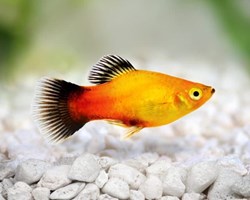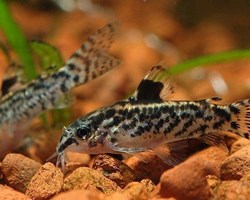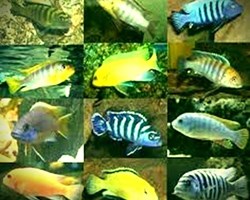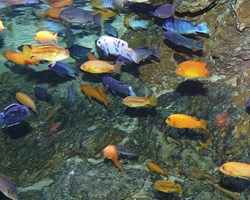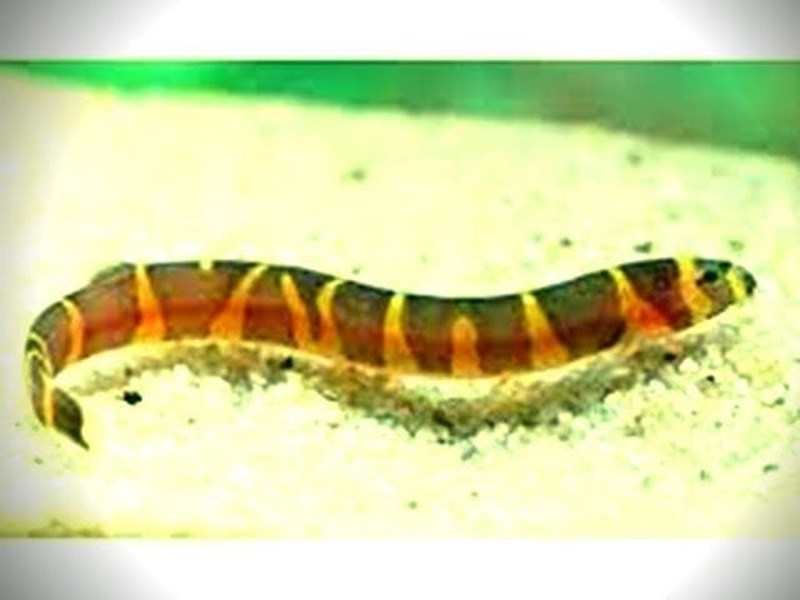
INDEX:
1.- DESCRIPTION OF PANGIO KHULII.
2.- BEHAVIOR AND COMPATIBILITY.
3.- CARE OF THE AQUARIUM.
4.- REPRODUCTION OF PANGIO FISHES.
5.- NUTRITION OF PANGIO KHULII FISH.
1.- DESCRIPTION OF PANGIO KHULII:
It is a fish that has an elongated and laterally compressed body.
The scales that cover their body are small and covered by a mucus that serves as protection when they are buried. They have a bony spine under their eyes, because it serves as a defense against predators and gives it the common name of "spiny slice".
Common name:
Kuhli, Spiny-eyed Loach, Spiny Loach, Kuhlii Loach.
Taxonomy:
Animalia Kingdom
Edge: Chordata
Class: Actinopterygii
Subclass: Neopterygii
Underclass: Teleostei
Superorder: Acantopterigii
Order: Cypriniformes
Family: Cobitiidae
?Genus Pangio
Species: P. kuhlii
Binomial name: Pangio kuhlii
Commonly known as Kuhlis, these striking species belonging to the Acanthophthalmus family are especially suitable for keeping them in community aquariums, individually or in groups, with other background species such as loaches or Corydoras included.
Coloration: Presents 15 to 18 dark and thick vertical stripes, frequently irregular, which are not completed on the ventral part. In the upper half of the caudal fin they present a quadrangular spot.
The base color is yellowish and the ventral part may have a pink coloration.
Its origin is from Southeast Asia where it lives in rivers and streams.
2.- BEHAVIOR AND COMPATIBILITY:
Kuhlis are highly recommended species for the community aquarium as long as they mix with non-territorial fish or that can prey on them.
The ideal would be to associate them with species of Asian origin such as rasboras, colisas, gouramis, barbels, botias and even Labeo bicolor despite the difference in size.
This mix would be the purist but due to their great adaptability they can be mixed with South American species such as Corydoras, Characins and even Discus fish.
Their presence is extremely beneficial because they spend their days looking for food remains in the substrate, removing it with the spines on their heads, benefiting its oxygenation and the settlement of natural plants. They do not eat detritus or feces from other fish. Only food that has been retained in the lower part of the aquarium and that the filter cannot retain and eliminate.
In nature, Pangio Kuhlii are social fish. They have crepuscular to nocturnal habits. They are able to withstand low oxygen levels since the intestinal mucosa performs respiratory functions. At dawn they rise to the surface in search of oxygen.
In captivity, they spend most of their time in shaded areas, sheltered in hiding places such as plants or rocks, so they are commonly seen only when they leave their hiding places during feeding periods. For this reason, these fish may not be seen for days or even weeks.
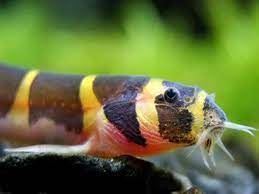
Acanthophthalmus Kuhlii, loaches for the community aquarium:
They have the peculiarity of having membranes that protect their eyes when they bury their heads in the substrate in search of food.
Due to their small size, they are able to penetrate completely into the substrate, leaving unexpectedly in the area that you do not expect.
Once they settle in the aquarium they are more difficult to capture.
They are highly elusive fish, very fast and naturally gifted to hide.
It is very curious how they wrap around any decorative object, including plants or with other specimens of their family. In no case is it a reproductive behavior.
3.- CARE OF THE AQUARIUM:
They prefer slightly acidic to neutral waters, between 6.5 and 7º pH.
Due between 8 and 10.
Temperature between 25 and 27ºC.
The aquarium should be provided with a substrate of fine or medium granulometry preferably.
We must provide shaded areas where the animals are comfortable protecting themselves in daylight hours.
Its activity takes place preferably with reduced lighting and even at night.
Despite its benefits as a natural cleaner, it should not confuse us with the idea of having to siphon the bottom of the aquarium periodically.
They require aquariums of more than 76 liters, the ideal would be 100 liters, with a lid, since they can jump, and a high density of floating vegetation to attenuate the incident light.
Debris or sand bottoms in which it can burrow and the presence of gravel to provide hiding places are also advisable. A large group should be kept due to its sociable nature.
4.- TYPES OF SPECIES OF THE GENUS ACANTHOPHTHALMUS:
The Kuhlis are very easy to identify in relation to other tankmates but not so to differentiate their different species.
The exact classification of the species is not always easy to carry out.
All Acanthophthalmus have an elongated, almost cylindrical body, laterally compressed on the caudal peduncle.
The barbels that it presents in its mouth are used to locate live prey, whether they are small crustaceans or worms.
The main color is yellowish pink.
The body is marked by dark brown bands present throughout its body.
The fins are small and transparent, which gives the fish a shape similar to that of snakes.
Acanthophthalmus Kuhlii:
The species that generally serves to denominate the rest when we are not clear about the species that we handle.
It is also called Locha khuli or colmilleja.
Its base color is yellowish pink and the bands that cross it are thick.
These bands reach the ventral area without completely covering the side of the animal.
It reaches a maximum size of between 8 and 12 cm.
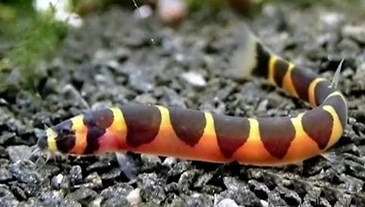
Acanthophthalmus semicinctus:
It is called Half Band Kuhli Loach.
Its appearance is very similar to the previous one.
Its base color is salmon pink.
The particularity is in its brown bands that are similar in thickness but half as short.
Size up to 8 cm.
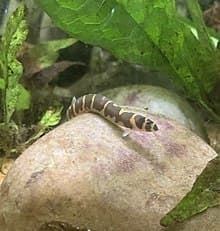
Acanthophthalmus Myersi:
Its shape is reminiscent of the two species mentioned, but its background color is cream and the width of its dark brown bands is much wider.
Some authors consider it a subspecies of A. kuhli and call it A. Kuhli Myersi.
It is the largest of all around 12 cm.

Acanthophthalmus shelfordi:
It is easy to recognize because its base is orange and its spots are tabby.
It is somewhat more slender and reaches sizes of up to 8 cm.
It is easy to recognize because its base is orange and its spots are tabby.
It is somewhat more slender and reaches sizes of up to 8 cm.
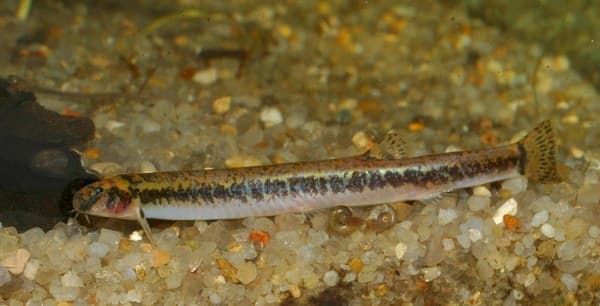
It is easy to recognize because its base is orange and its spots are tabby.
It is somewhat more slender and reaches sizes of up to 8 cm.
4.- REPRODUCTION OF PANGIO FISH:
Sexual dimorphism does not exist so sexing them is impossible.
We can look at the bulge of the abdomen in the case of females.
To attempt its reproduction we must resort to maintaining a group of individuals since they do not present intraspecific aggressiveness.
The aquarium should be profusely planted preferably with Sagittarius and floating plants. The females begin to swim on the leaves, leaving a trail of eggs that can reach a thousand. These once placed begin to detach and fall to the ground. The eggs are grayish in color and measure 1 mm in diameter.
Once the parents are fertilized, they abandon the laying. If the larvae survive, they hatch after 24 hours at a temperature of 26ºC. They will begin to feed around two weeks and it is essential to provide them with live food of their size.
The difficulty of differentiating the species reduces the probability of reproducing because they do not mix with each other.
Oviparous.
Breeding of this species in captivity has been rarely successful and mainly obtained by injecting the parents with hormones.
The presence of a group of three to five pairs of males and females apparently stimulates reproduction.
The male surrounds the female with his body, the eggs being released on the surface of the water and fertilized at the same time.
The clutches are very numerous and are generally found attached to the roots of floating plants. The eggs are very small and light green in color.
The incubation period is 24 hours at a temperature of 26 °C.
Egg cannibalism has been recorded.
5.- NUTRITION OF PANGIO KHULII FISH:
Pangio Kuhlii is an omnivorous fish.
They are bottom feeders and it is advisable to feed them at dusk as this is when they come out of their hiding places.
A wide variety of live, freeze-dried, or dried commercial foods can be fed, such as mosquito larvae, groundfish pellets, and pellets.
The larvae have external arborescent gills, and must be fed up to three times a day with microplankton and nauplii of Artemia.

